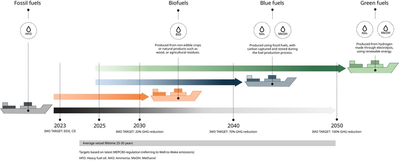Report: Sustainable Shipping Fuels Can Reach Cost Parity by 2035
Sustainable shipping fuels could reach cost parity with fossil fuels as early as 2035 with the help of decisive emissions policy such as carbon taxes and emissions limits, according to a new report launched by Wärtsilä.
The report, titled ‘Sustainable fuels for shipping by 2050 – the 3 key elements of success’, states that the EU Emissions Trading Scheme (ETS) and FuelEU Maritime Initiative will see the cost of using fossil fuels more than double by 2030. By 2035, they will close the price gap between fossil fuels and sustainable fuels for the very first time.
Existing decarbonisation solutions, such as fuel efficiency measures, could cut up to 27% of emissions. Wärtsilä's report argues that sustainable fuels will be a critical step in eliminating the remaining 73% but radical action is needed to scale them. The industry suffers from a “chicken and egg” challenge – ship owners won’t commit to a fuel today that is expensive, only produced in small quantities, and may be usurped by another fuel that scales faster and more affordably. Meanwhile, it is difficult for suppliers to scale production without clear demand signals.
Wärtsilä has produced new modelling that shows a timeline of which fuels are likely to become widely available on a global scale, when and at what cost. To accelerate this timeline, the report argues that decisive policy implementation, industry collaboration, and individual operator action must coalesce to scale the production of these fuels.
Decisive Policy: Wärtsilä’s modelling shows sustainable fuels will be 3-5 times more expensive than today’s fossil fuels in 2030. As ETS and FEUM show, policy is key to closing the price gap. The report argues that policymakers should:
• Maximise certainty: Set an internationally agreed science-based pathway for phasing out fossil fuels from the marine sector, in line with IMO targets.
• Boost cost competitiveness: Adopt a global industry standard for marine fuel carbon pricing.
• Collaborate: Increase global collaboration between governments on the innovation and infrastructure necessary to deliver sustainable fuels at scale worldwide.
Industry collaboration: The sector must collaborate with stakeholders from inside and outside shipping. The report calls on industry to:
• Pool buying power: Initiate sector-wide procurement agreements to pool demand from multiple shipping operators.
• Collaborate with other sectors: Convene with leaders in aviation, heavy transport, and industry to establish a globally recognised framework for the production and allocation of sustainable fuels.
• Share skills: Establish an industry-wide knowledge hub for the purpose of sharing expertise, skills and insights.
Individual actions: Every euro an operator saves in fuel costs at today's prices, could be worth 3-5 times that by 2030. That means companies such as Carnival Corporation, which made a 5-10% efficiency gain through its Service Power Upgrade Program, could cut its fleetwide fuel costs by as much as $750 million per year in 2030. All operators can benefit from improving the efficiency of their vessels – the technology is readily available today.
Investing in fuel flexibility is the most financially viable way to avoid the risk of stranded assets. Wärtsilä has been developing multiple fuel options. Most recently, Wärtsilä launched the first commercially available 4-stroke engine for ammonia fuel, which can immediately reduce emissions by over 70%, compared to diesel.
The report provides a roadmap for the future of sustainable fuels, identifying how the industry can more rapidly and affordably scale these fuels and achieve full decarbonisation by mid-century – within the lifetime of just a single vessel.














